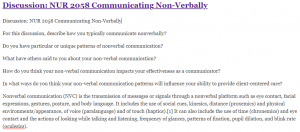Discussion: NUR 2058 Communicating Non-Verbally
Discussion: NUR 2058 Communicating Non-Verbally
For this discussion, describe how you typically communicate nonverbally?
Do you have particular or unique patterns of nonverbal communication?
What have others said to you about your non-verbal communication?
How do you think your non-verbal communication impacts your effectiveness as a communicator?
In what ways do you think your non-verbal communication patterns will influence your ability to provide client-centered care?
Nonverbal communication (NVC) is the transmission of messages or signals through a nonverbal platform such as eye contact, facial expressions, gestures, posture, and body language. It includes the use of social cues, kinesics, distance (proxemics) and physical environments/appearance, of voice (paralanguage) and of touch (haptics).[1] It can also include the use of time (chronemics) and eye contact and the actions of looking while talking and listening, frequency of glances, patterns of fixation, pupil dilation, and blink rate (oculesics).
The study of nonverbal communication started in 1872 with the publication of The Expression of the Emotions in Man and Animals by Charles Darwin. Darwin began to study nonverbal communication as he noticed the interactions between animals such as lions, tigers, dogs etc. and realized they also communicated by gestures and expressions. For the first time, nonverbal communication was studied and its relevance questioned.[2] Today, scholars argue that nonverbal communication can convey more meaning than verbal communication.[3] Some scholars state that most people trust forms of nonverbal communication over verbal communication. Ray Birdwhistell[note 1] concludes that nonverbal communication accounts for 60–70 percent of human communication,[4] although according to other researchers the communication type is not quantifiable[5] or does not reflect modern human communication, especially when people rely so much on written means.[6]
Just as speech contains nonverbal elements known as paralanguage, including voice quality, rate, pitch, loudness, and speaking style, as well as prosodic features such as rhythm, intonation, and stress, so written texts have nonverbal elements such as handwriting style, spatial arrangement of words, or the physical layout of a page. However, much of the study of nonverbal communication has focused on interaction between individuals,[7] where it can be classified into three principal areas: environmental conditions where communication takes place, physical characteristics of the communicators, and behaviors of communicators during interaction.
Nonverbal communication involves the conscious and unconscious processes of encoding and decoding. Encoding is defined as our ability to express emotions in a way that can be accurately interpreted by the receiver(s). Decoding is called “nonverbal sensitivity”, defined as the ability to take this encoded emotion and interpret its meanings accurately to what the sender intended. Encoding is the act of generating information such as facial expressions, gestures, and postures. Encoding information utilizes signals which we may think to be universal. Decoding is the interpretation of information from received sensations given by the encoder. Decoding information utilizes knowledge one may have of certain received sensations. For example, in the picture above, the encoder holds up two fingers, and the decoder may know from previous experience that this means two. There are some “decoding rules”, which state that in some cases a person may be able to properly assess some nonverbal cues and understand their meaning, whereas others might not be able to do so as effectively. Both of these skills can vary from person to person, with some people being better than others at one or both. These individuals would be more socially conscious and have better interpersonal relationships. An example of this would be with gender: women are found[citation needed] to be better decoders than men since they are more observant of nonverbal cues, as well as more likely to use them.

Discussion: NUR 2058 Communicating Non-Verbally
Culture plays an important role in nonverbal communication, and it is one aspect that helps to influence how learning activities are organized. In many Indigenous American communities, for example, there is often an emphasis on nonverbal communication, which acts as a valued means by which children learn. In this sense, learning is not dependent on verbal communication; rather, it is nonverbal communication which serves as a primary means of not only organizing interpersonal interactions, but also conveying cultural values, and children learn how to participate in this system from a young age.
Importance
According to some authors, nonverbal communication represents two-thirds of all communications.[9][10] Nonverbal communication can portray a message both vocally and with the correct body signals or gestures. Body signals comprise physical features, conscious and unconscious gestures and signals, and the mediation of personal space.[9] The wrong message can also be established if the body language conveyed does not match a verbal message.
Nonverbal communication strengthens a first impression in common situations like attracting a partner or in a business interview: impressions are on average formed within the first four seconds of contact.[9] First encounters or interactions with another person strongly affect a person’s perception.[11] When the other person or group is absorbing the message, they are focused on the entire environment around them, meaning the other person uses all five senses in the interaction: 83% sight, 11% hearing, 3% smell, 2% touch and 1% taste.[12]
Many indigenous cultures use nonverbal communication in the integration of children at a young age into their cultural practices. Children in these communities learn through observing and pitching in through which nonverbal communication is a key aspect of observation.
Do you need a similar assignment written for you from scratch? We have qualified writers to help you.
You can rest assured of an A+ quality paper that is plagiarism free. Order now for a FREE first Assignment!
Use Discount Code "FREE" for a 100% Discount!
NB: We do not resell papers. Upon ordering, we write an original paper exclusively for you.

